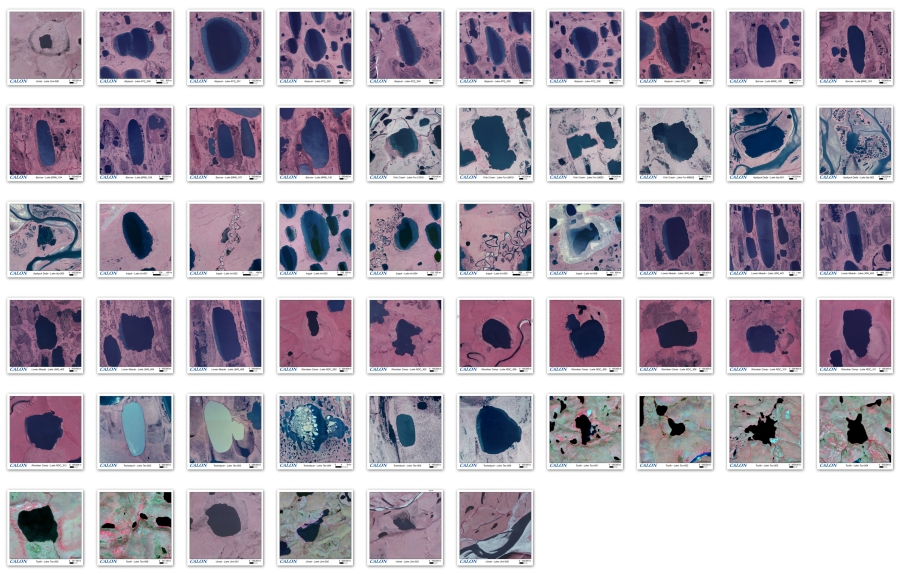Toward a Circumarctic Lakes Observation Network (CALON)--Multiscale observations of lacustrine systems
Project Personel
Main Contact:
Scientific Personel: K. Hinkel, R. Beck, H. Liu, C. Kim, A. Townsend-Small, and W. Eisner (Univ of Cincinnati), C. Arp and G. Grosse (Univ of Alaska-Fairbanks), J. Lenters (Univ of Nebraska-Lincoln), K. Frey (Clark Univ), and B. Jones (Alaska Science Center, U.S. Geological Survey)
Collaborators:
Partner Organizations:
Project Summary
About one-quarter of the lakes on earth are located in the Arctic, with their origin and distribution largely controlled by the presence of permafrost, glacial history, and the regional water balance. About half of the Arctic Coastal Plain (ACP) of Alaska is covered with lakes and drained lake basins, making these features the dominant landscape elements and a crucial component of the Arctic system. Lakes are intimately tied to the regional climate through their energy and water budgets and profoundly affect regional permafrost character. Arctic lakes release large quantities of carbon dioxide and methane to the atmosphere and absorb up to 35% more solar energy than the surrounding tundra during summer. Atmospheric effects on Arctic lakes, such as precipitation, temperature, radiation, wind, and humidity impact lake levels, water temperature, evaporation, mixing, ice cover, and lake productivity. Lakes play a vital role in the Arctic ecology, and there is concern that biological communities and lake productivity are vulnerable to the effects of climate warming. Water quality degradation and changes in lake hydrology are additional concerns for indigenous communities, since lake systems play a crucial role in Iñupiaq subsistence, culture, and heritage. In recognition of the importance of hydrology in a rapidly changing Arctic, the 2005 SEARCH implementation plan called for the establishment of a network of sites collecting key measurements of the water budget, and specifically identified the need to document and explain changes in lake surface area in the Arctic. The importance of lakes was also recognized by the authors of Toward an Integrated Arctic Observing Network (2006), who noted the lack of longterm, integrated, spatially extensive studies. Although a few previous studies have focused on individual lakes or lake processes, there has been no systematic collection of key lake parameters or baseline data with which to assess the impact of regional climate change. Researchers involved in this project have been working on lakes in Arctic Alaska for the past decade and are currently monitoring lake characteristics at a number of locations. As a first step towards developing a Circumarctic Lakes Observation Network (CALON), we propose to expand and integrate the existing network across the ACP of Alaska to provide data for key indices as defined by SEARCH and AON. Using in situ measurements, field surveys, and remote sensing/GIS technologies, we will provide raw data and processed images that will help fill the identified information gaps and facilitate knowledge sharing. The four scientific goals and methods that address the intellectual merits of the proposed research are: (1) Expand on existing lake monitoring sites in northern Alaska by developing a network of regionally representative lakes along environmental gradients from which we will collect baseline data to assess current physical, chemical, and biological lake characteristics. This will allow us to make spatial and temporal comparisons to determine the impact of warmer temperatures, changing cloud cover and precipitation patterns, permafrost degradation, and direct human impacts on lakes; (2) Implement a multiscale (hierarchical) lake instrumentation scheme such that basic data is collected from 69 lakes, while a subset of lakes are more intensively instrumented; (3) Provide regional scaling and extrapolation of key metrics through calibration and validation of airborne and satellite imagery with ground measurements; and (4) Develop and implement standardized protocols to enable inter-site comparison and to prepare for expansion towards a pan-Arctic network. The four education/outreach goals that address the broader impacts of the research outlined above are: (1) Incorporate indigenous observations of lake physical and biological characteristics and changes. Innovative interactive methods of sharing information will be developed and made available through native and local organizations. Scientific and technical training will be provided to Iñupiat students for monitoring lake and drinking water quality; (2) Develop a demonstration monitoring network based on the Delay Tolerant Network (DTN) architecture and link this network to research centers, indigenous communities, and other powerand connectivity-challenged environments; (3) Develop and refine data management, visualization, and archiving activities with CADIS; and (4) Provide an introduction to Arctic science for several Beginning Investigators.

All 56 CALON lakes currently monitored in northern Alaska:
- Lenters JD, Hinkel KM, Arp CD, Jones B, Frey KE, Grosse G, Beck RA, Eisner WR, Kim C, Liu H, Townsend-Small A (2012): Toward a circum-Arctic lakes observation network (CALON). American Water Resources Association Alaska Section Annual Conference. Juneau, Alaska, 5-7 March 2012.
- Hinkel KM, Lenters JD, Grosse G, Arp CD, Jones B, Beck RA, Eisner WR, Frey KE, Liu H, Kim C, Townsend-Small A (2011): Initial Results from the Circumarctic Lakes Observation Network (CALON) Project. AGU Fall Meeting 2011, San Francisco. C21B-0466.
- Arp CD, Jones B, Urban FE, Grosse G, Whitman M (2011): Shifting ice regimes of Arctic thermokarst lakes and implications for permafrost and surface-water dynamics. AGU Fall Meeting 2011, San Francisco. C31B-02.


